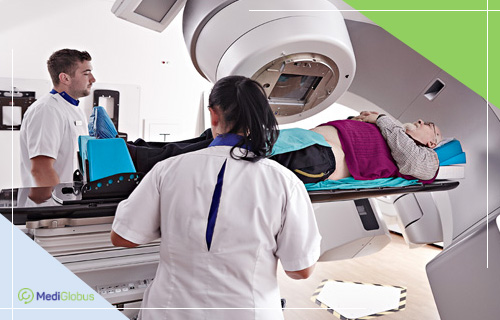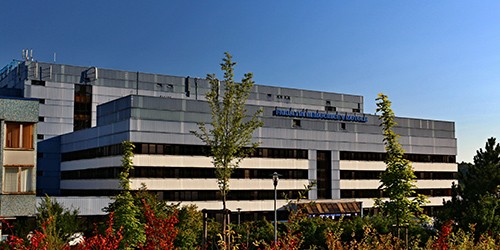Spinal haemangioma is one of the most common benign neoplasms of the spine. It occurs in 10-11% of the population. What does this diagnosis mean, should you be worried, and what should you do if you get diagnosed? Answers to these and other questions you will find in our article.
Vertebral haemangioma – symptoms and everything a patient needs to know about the disease

Hemangioma of the spine is a benign (non-cancerous) neoplasm that forms on the vertebral body from blood vessels. It is quite common among the general population – most often in women over 50 – and in most cases is asymptomatic. Many patients are not even aware that they have such a tumour in their back until it is accidentally discovered during diagnostics for another disease or check-up.
In most cases, haemangiomas do not pose a threat to the patient’s health. They grow slowly and can stop developing at a certain point. The only exception is pregnancy, which can provoke the progression of a previously asymptomatic hemangioma due to foetal growth and changes in the hormonal background.
Usually, hemangiomas of the spine are formed in the thoracic region, but it is possible to locate them in other areas – cervical, lumbar, etc. Rare forms of the disease include paediatric hemangiomas of the spine, atypical hemangiomas of the spine, multiple hemangiomas of the spine in different parts of the spine, and aggressive hemangiomas of the spine. The latter are characterised by rapid growth and spread into soft tissue, but are not cancerous.
In general, spinal haemangiomas are characterised by a positive treatment prognosis. In cases where the disease does not cause symptoms, most doctors recommend that no treatment be used and that they remain under observation. The only exceptions are aggressive hemangiomas that always require medical treatment. For large tumours that cause discomfort and other symptoms to the patient, there is a wide range of treatments available.
It is important to remember the symptoms only occur in 5% of patients and are not specific to this condition. The most common complaints are:
Spinal pain of moderate to high intensity, which may be localised or irradiating;
Swelling in the area of the vertebrae, usually sensitive to the touch;
Weakness, numbness, and tingling in the arms or legs;
Symptoms worsen during movement and subside if you lie down.
We should also separately mention some of the questions that often concern our patients:
Can spinal haemangiomas disappear on their own?
No, unlike paediatric haemangiomas, spinal haemangiomas do not disappear on their own and require medical intervention if symptoms are present.
What size spinal haemangioma is dangerous?
The key factor in deciding on surgery is not the size of the tumour, but the presence of symptoms, which in turn depends on which vertebra it is located in. The smaller it is, the smaller the neoplasm will pressure the tissue. For example, if the average size of hemangioma in the cervical vertebra is 3,6 cm, then in the sacral vertebra they can reach 8 centimetres or more.
In addition to the discomfort brought by the symptoms of this disease, untreated spinal haemangioma can cause dangerous complications.
What are the dangers of spinal haemangioma?
Without treatment, spinal haemangioma will worsen the patient’s condition and cause dangerous complications. These are rare, but patients should be aware of their risks. Among them are:
Rupture of the haemangioma with subsequent haemorrhage;
Nerve compression, radiculopathy, myelopathy (may manifest as mobility problems or paralysis);
Erosion of the spinal canal;
Vertebral misalignment;
Fractures resulting in kyphosis or hump formation.
Complications of spinal hemangioma are usually successfully treated, although they may require an additional intervention.
Spinal haemangioma: what can and cannot be done?
Doctors recommend avoiding physical exertion for patients with spinal haemangioma. Lifting heavy weights or back injuries can aggravate the condition. It is advised to avoid critically high or low temperatures, massage, and, like all people, a “sedentary” lifestyle.
To book this treatment abroad, click on the button below and fill in the form. Our coordinators will call you back within 30 minutes. They will provide all the necessary information and help you with travel arrangements.
Diagnosis of the disease
As mentioned above, in most cases, spinal haemangioma is detected accidentally during imaging diagnostics. X-rays are usually insensitive to this type of tumour – especially small ones, up to 1 cm – but MRIs and CT scans do a good job.
If the patient goes to the doctor with characteristic complaints of back pain, the doctor will also prescribe the necessary package of examinations. The main goal is to exclude other diseases that can cause similar symptoms, first of all – osteoporosis, various infections and cancer.
Diagnosis of spinal haemangioma must necessarily include a physical examination along with an assessment of the gastrointestinal tract and genitourinary system.
What spinal haemangioma looks like on different images:

MRI
On an MRI image, a spinal haemangioma appears as a light-coloured contrast spot on the vertebral body. Components made up of water and fat can be seen in the image.
CT
CT scans are characterised by a so-called “polka-dot” or “velvet” image – depending on the angle at which the image slice was taken.
The choice of spinal haemangioma treatment is made by the doctor based on the size and location of the tumour, the symptoms present, the risk of certain complications and the risks associated with the particular treatment.
Medical treatment of spinal haemangioma

The main method of conservative treatment of spinal haemangioma is embolisation of the tumour. During this procedure, the doctor injects alcohol directly into the neoplasm. The procedure is carried out under the control of CT, so the doctor constantly sees all the structures of the body, can observe his manipulations “from the inside”, and the risk of unpredictable complications is minimised.
The method is used for painful haemangiomas and allows to get rid of haemangioma in 70-90% of cases. Some medical centres recommend embolisation as the main method of treatment for radiculopathy or myelopathy.
As with any treatment method, embolisation of spinal haemangiomas carries risks. In most cases, the intervention goes without complications, but the patient should still be aware of what could happen. In a certain percentage of patients, the haemangioma recurs after embolisation. There is also a risk of abscess or a vertebral collapse.
Sometimes embolisation may be done before surgery, to reduce blood loss.
Radiation therapy for spinal haemangioma
Radiation therapy is the use of radioactive rays to destroy a spinal haemangioma. The procedure is usually performed in several sessions, during which the neoplasm will gradually decrease in size. Radiotherapy is used to treat painful and large spinal tumours.
Leading foreign clinics use the latest generation of equipment for radiotherapy. It allows the doctor to control the movement of the beam with an accuracy of up to a millimetre, and also to calculate the dosage of radiation using modern operational software. This increases the effectiveness of the treatment and reduces its side effects.
On average, researchers report about 79% effectiveness of this method. However, for some patients, there is a risk of vertebral fracture. In such cases, it is recommended to combine the procedure with vertebroplasty.
Some centres also treat hemangioma of the spine using Cyberknife. This is an innovative radio unit that performs “radiosurgery” – destroying the tumour with higher doses of radiation in one session.

Surgical treatment of spinal haemangioma
Surgery is the most radical method of treatment, so it is used in cases of progressive disease with a pronounced neurological deficit. The main goal is to remove the tumour tissue that compresses the nerves. As a surgical treatment of spinal haemangioma, various operations can be used: vertebroplasty, kyphoplasty, laminectomy, corpectomy, and spondylectomy. The size of spinal haemangioma suitable for surgery is considered to be tumours from 1 cm, but nuances (location of the tumour, dynamics of the disease and the presence of symptoms) play a major role here.
Vertebroplasty | Replacing the space left by the tumour removal with special bone cement. |
Kyphoplasty | A procedure similar to the previous one, with the additional step of creating space using a balloon-like device. Kyphoplasty can restore the height of the damaged vertebrae and may also provide pain relief. |
Laminectomy | The complete or partial removal of a part of the vertebra called the lamina. |
Corpectomy | Complete removal of the front part of the vertebra (body). The part of the bone that surrounds and protects the spinal cord is retained. |
Spondylectomy | The most invasive version of the surgery. The surgeon removes the vertebra and surrounding structures, including the intervertebral discs. |
The specific treatment method chosen depends on the size of the tumour and the extent of surrounding tissue damage. Doctors may combine treatments, such as vertebroplasty with laminectomy, to achieve the best possible spinal stability.
Where to go for quality treatment?
When choosing a clinic for spinal haemangioma treatment, you should consider various factors: the price of surgery, availability of modern equipment, surgeon’s experience, level of service, etc. We share a list of clinics with the best reviews from our patients, but we can also provide free personalised recommendations of hospitals and specific doctors based on your criteria and budget. Just leave a request on our website and wait for a call from our physician coordinator, who will assist you with all relevant questions.
Summary
Spinal haemangioma is a common benign tumour that forms from blood vessels. In cases where the tumour does not cause any symptoms, it will not require treatment.
If a spinal hemangioma causes pain, tingling in the extremities, impaired mobility, weakness and numbness – it requires treatment. To this end, doctors use ablation, radiation therapy and carrying out surgery. Often, a combination of several of these methods may be necessary to achieve the best effect.
Without proper treatment, symptomatic spinal haemangioma can lead to dangerous complications such as nerve compression, vertebral fracture, paralysis and haematoma.
For quality and safe spinal haemangioma treatment, we recommend the following hospitals: Teknon Hospital (Spain), Medicana, Koç Hospitals (Turkey), Motol Hospital (Czech Republic), Anam Hospital (South Korea), and Assuta Hospital (Israel).
To book this treatment abroad, click on the button below and fill in the form. Our coordinators will call you back within 30 minutes. They will provide all the necessary information and help you with travel arrangements.
Sources:
- 1. StatPearls Publishing
- 2. Radiopaedia.org
- 3. Clinical Neurology and Neurosurgery: Vertebral hemangiomas: Diagnosis and management. A single center experience
- 4. Journal of Spine Surgery: Vertebral hemangiomas: common lesions with still many unknown aspects
- 5. British Journal of Radiology: Aggressive spinal haemangiomas: imaging correlates to clinical presentation with analysis of treatment algorithm and clinical outcomes
- 6. Journal of Radiosurgery and SBRT: Cyberknife radiosurgery for the treatment of disabling pain caused by vertebral body hemangioma












